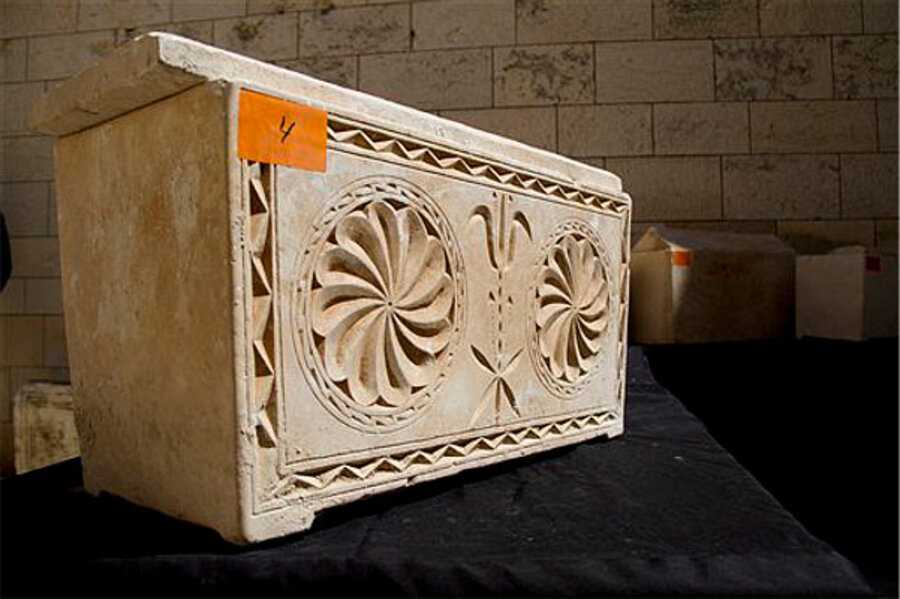Real-life tomb raider? 11 ancient boxes of bones recovered in Israel
Loading...
| JERUSALEM
Israeli authorities on Monday unveiled 11 ancient burial boxes dating to around the time of Jesus, recovered by police during a midnight raid on antiquities dealers suspected of stealing the artifacts.
The boxes include a pair of ossuaries believed to contain the remains of two noblemen who lived in Jerusalem some 2,000 years ago.
Some are engraved with designs and even names, giving clues to their origin and contents. The boxes contain bone fragments and remnants of what experts say is pottery buried with the deceased.
Israel's Antiquities Authority said the boxes were recovered last Friday, shortly after midnight, when police observed two cars parked suspiciously at a military checkpoint on the outskirts of Jerusalem. When they investigated, they found four people involved in an exchange of the boxes. Once police recovered the items, they alerted the authority.
Police spokesman Micky Rosenfeld said the boxes were "stolen from a cave" near Jerusalem with the intent of being sold to collectors. He said authorities had been tracking the suspects for some time but would not elaborate. The exchange involved an Israeli and a Palestinian seller attempting to make the sale to an Israeli customer, he said.
According to Israeli antiquities law, all antiquities that are discovered are considered property of the state.
Two of the suspects remained in custody on Monday, and the others were under house arrest, according to the authority.
The boxes, known as ossuaries, are believed to date back to the Second Temple Period, a time stretching from roughly 515 B.C. to 70 A.D. that included the reign of King Herod, who built some of the most famous sites in Jerusalem and the Holy Land, and the time of Jesus.
Not unlike today, the Jerusalem of the time was a place of strong religious divisions, multiple languages and a diverse economy. Visitors made pilgrimages from far and wide, bringing with them commerce and traffic on religious holidays.
According to common Jewish burial practices of the time, the deceased were not buried but laid out in a cave for one year. Afterward, the bones were gathered and stored in the special boxes.
"It's kind of like where the deceased go to retire," said Stephen Pfann, president of the University of the Holy Land. Pfann noted that the use of these burial boxes developed at the time partly to condense the space needed once the corpse had turned to bones and partly because of the difficulty of finding space for a tomb in Jerusalem's hard bedrock.
Some of the newly recovered boxes feature elaborate engravings, indicating wealth and a high social status of the deceased.
"It was an expense to cut a tomb at all," said Pfann. "It definitely took a certain amount of wealth."
The boxes are not especially rare. The Antiquities Authority already has in its possession over 1,000 of these ancient boxes. But the authority's deputy director, Eitan Klein, said that each box was significant.
"We can learn from each ossuary about a different aspect of language, art and burial practice," he said. "And we can learn about the soul of the person."
Two were inscribed in Hebrew with names — "Yoezer" and "Ralphine." Klein said that he hoped to learn more about the identity of the deceased through future research.
According to Klein, the boxes held the remains primarily of rabbis, businessmen and aristocrats of the time. The use of ossuaries became popular during the 2nd century B.C., influenced by the individualism of Greek and Roman societies. They fell out of fashion, Klein said, after Roman domination of Jerusalem in 70 A.D.
Klein estimated the value of the boxes to be in the thousands of dollars.
In the past, allegations of forgery have been made over certain ossuaries and their inscriptions.
In one of the most famous cases, doubts still linger over a 10-year forgery investigation into the origins of an ossuary claimed to be inscribed with a reference to Jesus Christ. The case was closed in 2012 with no one convicted of forgery.
Klein said he had no questions about the authenticity of the latest discovery, given their engravings and contents.
"These ossuaries are authentic," he said. "Everything here smells authentic."
Copyright 2014 The Associated Press. All rights reserved. This material may not be published, broadcast, rewritten or redistributed.







